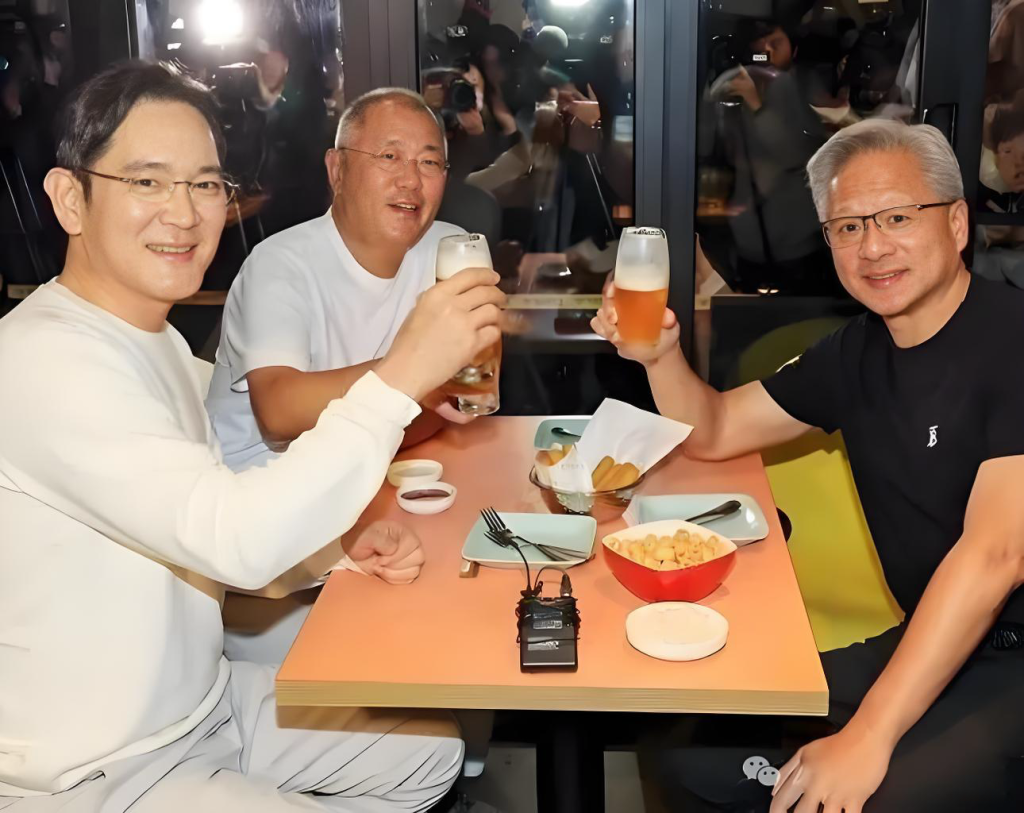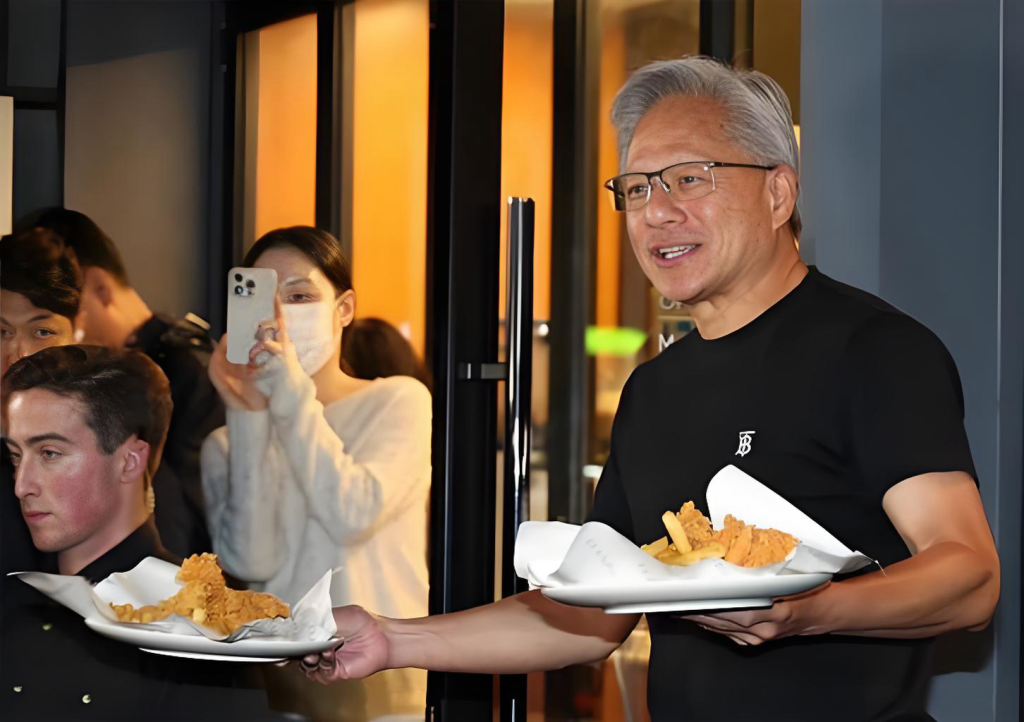After a 15 year absence, Nvidia CEO Huang Renxun visits South Korea again. With the sound of “buddy” and a glass of beer, Huang Renxun had a great conversation with the South Korean tycoons at the dinner table. His true intention was probably to use the friendship formed by the “team” to stitch together the two key concerns of Nvidia’s computing power empire.

This week, Nvidia became the first company to surpass a market value of $5 trillion, as if holding the throat to the AI era. But behind the glory, Nvidia also has certain hidden concerns in terms of supply and market. Samsung and the Korean market may become a key factor in addressing these two major concerns.
Therefore, on the last day of October, when Huang Renxun, along with Samsung Electronics Chairman Lee Jae yong and Hyundai Motor Group Chairman Jung Yi sun, held up beer glasses at a fried chicken restaurant called “Kkanbu Chicken” in Seoul, it was not just a simple gathering, but more like a carefully planned strategic announcement. Under the watchful eye of nearly a thousand people and the spotlight of global media, Huang Renxun completed a high-level “vertical and horizontal integration” in the most down-to-earth way.
“Kkanbu”, In Korean, it means “close friend, teammate” and is a symbol of childhood friendship. Huang Renxun’s move sends a clear signal to the two major conglomerates in South Korea: we are not simply suppliers and customers, but partners who share weal and woe.
The core weapon of Nvidia’s AI hegemony is GPU (Graphics Processing Unit), and the production of GPU currently heavily relies on TSMC. In addition, GPUs also require HBM (High Bandwidth Storage) to provide video memory support.
With the global AI arms race intensifying, wafer production and HBM supply have become the biggest bottlenecks for Nvidia’s capacity expansion. Samsung is the best choice for Nvidia’s wafer production and HBM’s second supplier.
The meeting with Samsung President Lee Jae yong was essentially a ‘supply chain defense war’. Huang Renxun needs to ensure that Nvidia can obtain the most stable and top-level “ammunition” supply in future production capacity competitions, firmly grasping the lifeline of the supply chain in his own hands.

When I used Samsung GDDR (video memory), you were still a child. ”Huang Renxun made such a joke about Li Zairong.
This joke is more of a respectful compliment than the arrogance of the predecessors. Behind it is a magnificent history of competition for storage chips.
This storage wave that ushered in the era of computer programming began with Intel, and in the 1980s, Japanese manufacturers became famous. However, it was ultimately crowned king by two Korean manufacturers, Samsung and SK Hynix, who firmly held the throne of the global storage market for the next two to three decades.
This fried chicken market is not only for supply, but also for the market. Especially in the future where the demand for inference far exceeds the demand for training, the importance of ecology and cost-effectiveness is stronger than pure chip performance. Therefore, building a full stack ecosystem to seize the application market has become the focus of competition among major giants.
Huang Renxun’s Korean fan meeting? On site inquiry to investors: How much did it cost to buy it five years ago?
Huawei Shengteng, Cambrian, Kunlunxin, Moore Thread, Muxi and other Chinese chip companies are working together with Alibaba, Tencent, ByteDance and other cloud service giants to build an independent AI computing ecosystem. Although there is still a gap in single point performance at present, the above-mentioned enterprises are forming an undeniable force with their huge local market and increasingly close industrial synergy.
From GPGPU (General Graphics Processing Unit) to AI ASIC (Artificial Intelligence Application Specific Integrated Circuit), from PCIe Switch (an interconnect chip) to HBM, these manufacturers are forming a “group army” style pursuit from multiple dimensions such as computing power, transportation capacity, and storage capacity.

This force not only brings warmth to the Chinese market, but also has the opportunity to penetrate the global market and establish a “second world” independent of the NVIDIA CUDA (GPU Universal Computing Solution) ecosystem. This poses the most fundamental long-term threat to Nvidia’s GPGPU sales.
Therefore, it is necessary for Huang Renxun to consolidate Nvidia’s “basic foundation”. This time, Nvidia has signed contracts with Samsung Electronics, SK Group, Hyundai Motor Group, and NAVER Cloud. Specifically, the South Korean government will receive 50000 GPUs, Samsung Electronics, SK Group, and Hyundai Motor will each receive 50000 GPUs, and NAVER Cloud will receive 60000 GPUs.
The small fried chicken restaurant in Gangnam gu, Seoul, exudes not only the aroma of beer and fried chicken, but also the strategic atmosphere of a tech giant’s visionary leader. Huang Renxun used a seemingly effortless “fried chicken diplomacy” to perfectly integrate cultural symbols and commercial interests.
However, when the water is full, it overflows; when the moon is full, it is short. Although Huang Renxun’s “Fried Chicken Alliance” is ingenious, its excessive reliance on a single regional supply chain is itself a sword of Damocles hanging over its head. No matter how much warmth and friendship there may be, it is ultimately no match for cold commercial interests.
When cracks appear in the alliance, when the “pack of wolves” find new breakthroughs, today’s toasting may become the prelude to the setting sun of tomorrow’s empire.










暂无评论内容